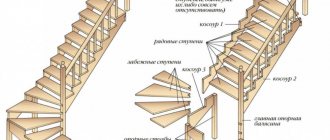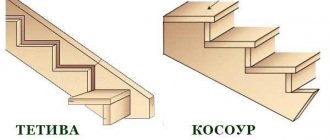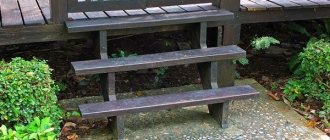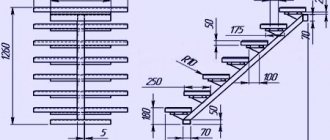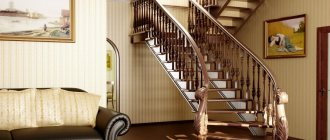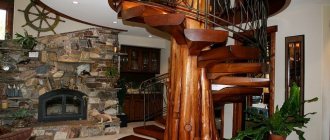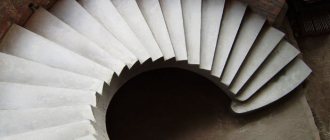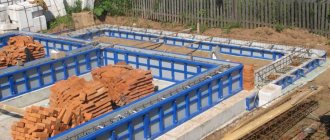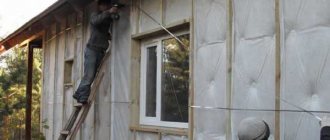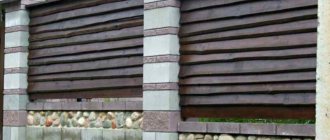Installing a wooden staircase with your own hands is a labor-intensive and quite complicated process for a beginner, as it requires certain training, skills and abilities.
It is obvious that securely fastened and perfectly adjusted staircase elements make the structure as stable and reliable as possible, eliminating creaks, swaying and deformation. However, novice craftsmen often neglect simple rules, which leads to distortions, premature destruction and other extremely unpleasant consequences.
In this article we will try to talk about the key points of assembling and installing rotary flight stairs so that you do not make mistakes in practice.
If you don't have a finished project, we recommend that you use our online staircase calculator . It allows you to receive a ready-made estimate, a set of drawings, a 3D model and recommendations for manufacturing the most convenient design.
Content
- Introduction
- Wood grain direction
- Wall stringers
- External stringers
- Connecting stringers to each other
- Attaching steps to a string - methods
- Methods of fastening balusters
- Installing railings on stairs
- Attaching the handrail to the pole
Introduction
Installation of a staircase, like any other structure, is carried out in stages. First of all, parts are always installed that perform the function of load-bearing elements and access to which will be difficult in the future.
However, each master has his own exact sequence of assembling individual elements, and any of these methods does not claim to be the only correct one.
To avoid asymmetry, after each stage of work, check with a level that the horizontal and vertical projections are observed.
Wood grain direction
When manufacturing staircase elements, you should pay special ATTENTION to the direction of the wood grain . Drawings must be transferred to the source material, taking this feature into account, along the greatest direction of the template.
Wood has such a quality as anisotropy - that is, its physical and mechanical properties differ depending on the direction within the medium. For example, the compressive strength of wood along the fibers is 3-4 times greater than across the grain, the tensile strength is more than 30 times greater, and the indicators for fracture and chipping are similar. Professional carpenters know these nuances and produce products in accordance with certain rules that allow them to achieve the highest possible reliability of the final product.
For example, the winder step at the junction with the turning post has a rather small support surface, as a result of which an increased load is applied to this place. If the wood fibers are located parallel to the front edge (that is, along the larger side), the load is distributed evenly over the entire element , and if perpendicular, then near the attachment point, a break will soon occur along the direction of the fibers in the narrowest place.
The situation is similar with stringers in places where steps are cut - the direction of the wood fibers must be parallel to the upper and lower edges of the board. Otherwise, unreasonable arrangement of fibers will definitely lead to the appearance of a defect.
Attaching support posts to the floor
Support pillars are vertically located load-bearing elements that form the basis of the frame of the lower part of the staircase. They provide support for the winder steps (landing) and the stringer (string).
There are no special requirements for the wood of the part - the main thing is that it is uniform, without cross-layers and large knots. Typically made from the same type of wood as the rest of the staircase.
In order for the future structure to be strong and reliable, the pillars must be firmly secured. This can be done using steel angles, studs, zip bolts, wood glue and other devices - there are a lot of options.
Finally, it is recommended to connect the columns with supporting stiffening beams.
Of course, by this time, all the technological holes and grooves for other elements of the staircase should already be made in the pillar structure.
Installation of a stringer
Stringers are the main load-bearing elements of a flight of stairs, which are mounted at an angle to the adjacent floor. Do-it-yourself installation of stair steps is carried out directly on the stringers, in pre-prepared recesses.
Wall stringers
Installation of the supporting structure begins with the installation of a wall stringer. For convenience, it is recommended to make markings on the wall in advance and, immediately before assembly, additionally double-check the accuracy of the structure with a level.
It is highly recommended to glue all connections and fastenings of parts with liquid nails or glue.
Usually the installation process begins with fixing the lower part of the stringer. To do this, the beam is installed and pressed into the groove connection or groove on the support column. A temporary support structure can also be made if it is planned that the stringer will be supported on the outside of the support column.
Then they begin to attach the upper part of the stringer. Depending on the type of floor: wooden, metal, concrete, different types of fasteners can be used. For example, in wooden houses, it is preferable to use angles, bolts, studs and anchors.
To strengthen the structure, it is also recommended to install stringers in the cuts of the load-bearing floor beam.
At the final stage, the main section of the beam must be pressed against the wall with pre-prepared dowels or anchors.
In order to prevent squeaks from adjacent structures in the future, all joints should be generously rubbed with paraffin, except for those where glue will be used.
External stringers
Installing an external stringer is practically no different from a wall stringer. By analogy, it is necessary to secure the lower part of the beam in any convenient way and then fix the upper part, which is adjacent to the ceiling.
During work, you need to ensure that the stringers are positioned exactly opposite each other, otherwise the design will turn out crooked and many manufactured parts will have to be modified.
After installing both beams, you will end up with something similar.
If necessary, the attachment point of the stringer and support beam is additionally reinforced with a metal corner.
Connecting stringers to each other
There are options for non-standard designs, when the stringers are not fixed in the grooves of the support posts, but are attached to them from the outside, or when only one support post is used, and the internal stringers are held only by fastening to the wall. In this case, the question often arises: how to fasten the stringers together?
The most common and universal method is the tongue-and-groove connection. This is quite simple to manufacture, but the most reliable unit that allows you to rigidly fix the parts. If, in addition, you treat the joints with PVA glue, then if the standard loads are observed, such a structure will be almost impossible to destroy.
together using ordinary self-tapping screws, screws or flush bolts (shown schematically in the figure with the screw head protruding outward). This connection also makes it possible to achieve high structural strength, but it can only be used if the stringers are planned to be attached to the support beam.
The second method involves cutting down the grooves in the support column, cutting one of the stringers to the thickness of the other, installing them in the appropriate holes and tying them together with any hardware. The resulting connection will firmly secure the elements of the staircase, and is also guaranteed to protect the structure from creaks and loosening.
On our website you can also calculate the length of the stringers and the amount of materials for their manufacture.
Calculation of parameters of a flight of stairs
An example of calculating a flight of stairs.
When making all calculations prior to construction, the process should take into account the need to build a structure that would enable a person to use it easily and comfortably. Such a structure, properly executed, should allow you to move along it even at night, without feeling for the next step with your foot, but using your usual step.
There are averaged data on the dimensions of stair elements, which are taken as a basis for calculations. The slope of the march should be within 33-45°.
It is believed that movement along a flight of stairs is most comfortable if the movement from a step to the nearest tread fits into a person’s normal step. Therefore, with an average step size of about 600 mm, the height of the step (riser) should be in the range of 150-200 mm, and the tread width should be at least 200 mm. Based on the given data, you can determine the parameters of the future staircase.
Calculation of the height and width of the step.
For example, when choosing the optimal inclination of a flight of stairs at 38°, you should build a model of a right triangle, the vertical leg (H) of which will be equal to the sum of the height of the room and the thickness of the floor of the first floor, the horizontal leg (P) will correspond to the bottom of the stairs, and the hypotenuse (L) of this triangle will be equal to the length of the designed march.
The length of the march is found by dividing H by the sine of the angle 38°. If the height H is 3000 mm, the flight inclination angle is 38°, then in this case L = 3000/0.616 = 4870 mm. The sole P of the staircase structure is determined by multiplying the hypotenuse L by the cosine of the angle 38° and will be equal to 4870 x 0.788 = 3840 mm.
The number of steps (n) is determined by dividing the height H by the height of the steps (risers) (h), recommended at 200 mm.
As a result of the calculation, we obtain: n = 3000/200 = 15. This number of steps is considered optimal and not burdensome for climbing. However, it should be borne in mind that the last, top step coincides with the floor of the second floor, therefore it is not taken into account when calculating the width of the treads.
To determine the width of the steps (p), the length of the sole of the flight P should be divided by the number of steps (n - 1): p = 3840/14 = 274 mm. It is recommended to set the width of the stairs from 1000 to 1500 mm. It is made the widest if it is possible for 2 people to pass on it at the same time.
It is also necessary to pay attention to the gap between the ceiling of the first floor and the crests of the steps. It should not be less than 1900-1950 mm.
The next step in constructing a staircase should be the choice of material that will harmonize with the design of the house and, of course, meet the required quality. Oak, beech or softwood work well for this purpose.
A product for lifting to a floor is one of the main elements of a multi-storey building.
High-quality installation of such a design requires accurate calculation of the product parameters and compliance with all rules during installation. After all, the staircase should be easy to use, reliable, and also fully suit the interior of the room. Below we describe in detail how to properly install the stairs to the second floor.
Lifting design
Attaching steps to the stringer
The next stage of building a staircase to the second floor with your own hands is attaching the steps to the stringer.
In cases where the design of the staircase also requires the presence of risers, it is recommended to install them first.
Let us remind you that the height of the risers should be approximately 1-2 mm less than the height of the steps. This is done so that in cases of increased humidity, when the wood swells, deformation of the entire structure does not occur.
After this, you can begin to directly install the steps. Straight elements along the stringer are installed simply and there is no point in going into detail, but the installation of winder steps should be considered in more detail.
There are two main ways to install winder steps:
- tongue-and-groove connection (classic);
- connection with the cut of the support column.
The first method assumes that in order to install the rotating elements, you will need to make blind grooves in the main support column. The vast majority of experts recommend making grooves slightly smaller than the thickness of the step, as this will allow the elements to be connected as tightly as possible and prevent their movement. In turn, this will prevent deformation of the structure and eliminate the appearance of squeaks.
The second method involves cutting through the support column to a thickness equal to the thickness of the step. The entire structure is fixed using wood glue or a pin wound inside the support column. To strengthen the selected connection, it is also practiced to create small grooves (locks) in the rotary stage to securely fix the entire assembly.
The outer side of the step, in both cases, must be attached to the frame made of winder stringers or supporting stiffening beams using PVA glue or self-tapping screws. If necessary, all connections are reinforced with metal corners.
Our website has a program for calculating winder steps - you will have access to drawings with actual dimensions, technical specifications and the amount of materials for manufacturing.
Types of interfloor stairs
Stairs located between floors can be divided depending on their features into groups according to:
- placement - inside and outside the house, inside the building, open or placed in a shaft. The staircase on the second floor in a private house is almost always located inside the building;
- construction method - prefabricated (from large modules or individual parts), monolithic (reinforced concrete and concrete), metal (with an open or hidden metal frame, usually made in combination), wooden (self-supporting);
- purpose - main and auxiliary, including rescue and fire fighting;
- material – concrete and reinforced concrete, brick, stone (natural and artificial), metal, glass, wood, polymers, combined;
- by type of installation - cantilever (mounted into the wall using crowns or directly steps); on one or more stringers, bowstrings, on bolts (special parts that fasten the steps into a solid structure), suspended on cables;
- by type of steps - with a riser, without a riser, with a partially closed gap between the steps;
- according to the number and shape of flights of stairs - straight single- or multi-flight (usually double-flight), rotary (in the form of the letters G, P, S, spiral-helical, quarter- and half-turn, circular, curvilinear, combined;
- by the presence of landings - absent or present (one, two, three or more);
- according to the shape of the steps - straight, winder (screw and rotary), "goose (duck) step" (the steps are located symmetrically relative to the line of travel), combined;
- stationary and folding (hinged, sliding).
The choice of a specific type of interfloor staircase depends on the area of free space for the structure, the convenience of placing a particular type and the reliability of its fastening. It is also necessary to take into account the question of how to make railings for stairs - their presence is mandatory in residential and public premises. We have prepared a separate article for you about building a winder staircase with your own hands. Here all the nuances associated with this type of staircase design are described in more detail.
Types of stairs
When deciding on the type of staircase, it is important to keep in mind the weight of the structure: for lightweight frame-type buildings and wooden houses, monolithic models made of reinforced concrete or solid metal are inappropriate, since they create an excessive load on the base of the building. Light wooden, combined and metal frame options can be installed in any building. Choosing a folding staircase makes sense if you rarely visit the floor (for example, the technical floor of an apartment building or the attic of a private house).
The compactness of the staircase is important in small-sized private houses, but the installation of such models is limited by the physical capabilities of the users. If there are elderly people with coordination problems and small children in the family, it is advisable to choose the traditional option. If you are wondering how to make a staircase to your dacha, you can use cooler and more compact models, provided they are rarely used.
Installation of ladders on a bowstring
The string is the main load-bearing element of the staircase structure, which is located in an inclined plane relative to the surface of the floor/ceiling.
The main difference between a bowstring and a stringer is the method of installing the steps. On the bowstring, the steps are installed from the inside into pre-cut grooves, and on the stringer they are placed on top in special recesses.
When assembling the entire structure, it is assumed that first the treads and risers are installed on one string and only then the second one is pressed on the other side using a special hammer.
This design feature predetermines some difficulties when installing a staircase, since you first have to assemble a whole flight (string along with steps) in one place, and only then secure this bulky structure in another.
The remaining stages of installation exactly coincide with the stairs on stringers.
It should also be noted that bowstring ladders have greater bending strength, but due to drying of the wood and the lack of uniform lateral adhesion, the sidewalls are able to move slightly apart over time. Therefore, this type of structure is often reinforced with cords, which can be made of wood or metal. They are recommended to be installed at the beginning, middle and end of the flight or every five steps.
Attaching steps to a string - methods
The classic version of assembling a wooden staircase with your own hands implies that the steps must be assembled before the march structure is installed in a given location. In this case, at the initial stage of assembly, all joints of the elements are lubricated with a special adhesive, risers and treads are inserted into the grooves, and, if necessary, reinforced with self-tapping screws.
However, recently designs with overhead bars and corners have become increasingly popular. In this case, specially placed stops are attached using nails or self-tapping screws directly to the body of the bowstring, and the tread, in turn, is installed on them.
In this case, the assembly of the stairs is carried out by analogy with the structure on stringers, that is, there is no need to first assemble the entire flight and only then install it at a given position.
A bowstring staircase is an excellent solution for a spacious home; try our tool to get a finished design project.
Marching structures
Construction of a flight of stairs.
The most famous and popular type is staircases. This is a classic in staircase construction. They are characterized by straight flights, that is, directly located load-bearing beams made of wood, metal or concrete, on which steps are rigidly attached from above.
The supporting beams of these marches are called stringers. This is the main detail of the flight of stairs. The stringers can be supplemented by the so-called bowstring - an inclined beam running along the side of the flight of stairs, to which the steps are attached at the end.
Staircase structures may include vertical enclosing devices - railings, consisting of vertical posts of various types, covered on top with a strip of handrail that serves for support. In addition, the steps themselves can consist of both horizontal crossbars - treads - and horizontal and additional vertical parts - risers. The risers are mounted between the treads, setting the height of the step and further enhancing the load-bearing capacity of the staircase structure.
Flights of such structures are usually located at an angle to the floor of no more than 450, therefore, to accommodate a staircase (the so-called vertical opening in which the stairs are located), a platform is required, the dimensions of which will be no less than 1600x1600 mm. Accordingly, the lower the slope of the flight of stairs, the larger the area required to construct the cage.
DIY installation of balusters and railings
Assembling the staircase railing is the last and one of the most important stages of installation. Durable railings ensure safe operation of the structure; they must protect people from accidental falls and must withstand the weight of people when leaning on them.
To achieve this effect, there are certain recommendations that determine the most optimal location of the balusters. For example, the clearance between the columns should be in the range of 15-20 cm; this does not make the structure much heavier, but prevents a child from falling from the second floor. It is also recommended to maintain the height of the handrail at 90-110 cm, since this is the most optimal value that will be convenient for the average person to support.
Methods of fastening balusters
To ensure that the railings are safe, stand firmly and do not wobble during use, several proven methods of attaching balusters are used:
- metal studs;
- metal platforms;
- dowels;
- self-tapping screws
Steel studs
Steel studs are one of the most popular fastening methods, as they provide the greatest strength of the connection. Experienced specialists recommend using studs when installing support balusters.
Based on the type of rod, they are divided into smooth and threaded.
In the first case, to create a strong connection, you need to drill a hole in the baluster at least 4 cm deep, add some liquid nails, carefully hammer in the existing pin and wait until the glue dries completely. After this, you need to make a similar cavity in the floor surface, also lubricate it with glue and connect the parts.
In the second case, you will also need to make a hole, but with a diameter 0.5-1 mm smaller than the diameter of the pin so that the wood does not crack when twisted. You can screw the rod into the support post using a lock nut.
It is also worth noting that mounting the structure on studs is only possible when the elements are placed perpendicularly, so it is impossible to use this method for a bowstring.
Metal platforms
Metal platforms are a fairly modern type of connection, which also allows you to completely hide all fastening elements.
The principle of operation of the mechanism is extremely simple - there is a steel platform in the shape of a lock, with four fastenings for self-tapping screws around the perimeter. In the middle there is a widened hole into which the bolt head is inserted, and a narrower elongated hole has a beveled side on the inside. Thus, by driving the head of the fastener inward and hammering it to the far side, we obtain a strong locking connection.
A fence completely installed in this way cannot be moved after all the supporting columns have been installed, but individual elements can be easily replaced if broken if you tap a mallet in the direction of the lock extension.
The main disadvantage of this connection is its applicability only in the horizontal plane - for a beveled march, it is necessary to use other types of fastening.
Wooden dowels
Dowels are cylindrical fastening products in the form of a short rod, most often made of wood.
They are used for fastening intermediate fencing elements or in cases where a threaded connection cannot be used, for example, on beveled surfaces.
The installation method is similar to installing smooth studs - first, a hole equal to half the length of the dowel is drilled in the end of the baluster, then it is filled with wood glue, and only then a wooden rod is installed there. After one connection has acquired the necessary strength, the pole is attached to the stairs.
The disadvantage of this type of fastener is the inseparability of the resulting assembly and, as a result, possible damage to adjacent structural elements during dismantling.
Marking and production of elements
It is quite possible to make an inexpensive, easy-to-make, straight staircase yourself if you carefully study the drawings and equally carefully manufacture each component element of the staircase. Of course, not all materials are available for self-production, so the optimal solution may be to make a staircase from wood.
The progress of the work is approximately as follows:
- based on the drawings, templates of typical step and riser parts are cut out of a board of the required thickness with a prepared surface;
- bowstrings or stringers are marked exactly according to specified dimensions or a pre-made template;
- all cutting areas are cleaned and polished;
- for marking you should use a carpenter's metal corner and a pencil;
- When marking the material, precise adherence to dimensions and angles is necessary.
You can take a different route: order the production of individual elements in special workshops. If you provide your own material and carefully performed calculations, the blanks for the structure will be relatively inexpensive. But in this option, the professional quality of the products will be guaranteed.
Construction supermarkets have a large selection of steps, balusters, railings, stringer beams and bowstrings - it is possible to purchase these products according to calculations. In this option, financial calculations must be made, but there will certainly be benefits.
